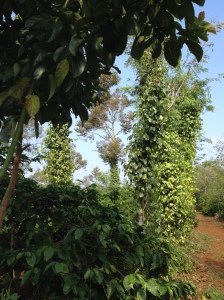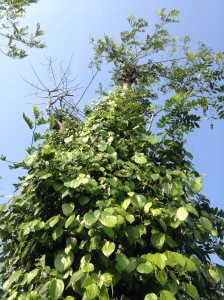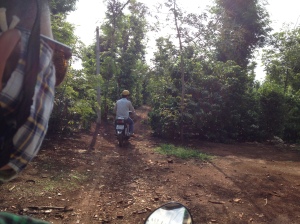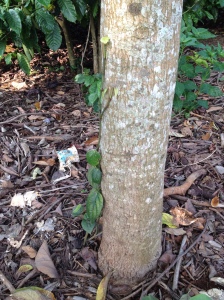(Part 1, Daklak province in Vietnam)

Agroforestry in a robusta field: Avocado to the top left, coffee to the bottom left, columns of black pepper and durian in the distance.

Before the robusta coffee bean, before your instant nescafe coffee. Behold, the cherry-laden branches of a coffee tree!
In the month of May, I went to Daklak province in Vietnam’s Central Highland region, an 8 hour sleeper bus-ride from the city of Saigo. I hung out with my college friend Quang and his wonderful family, who grow coffee among other things. It marked a change in how I had been working on my thesis on robusta coffee – a change from thinking and reading to talking to people who grow this stuff for real. I was lucky to be invited to his aunt and uncle’s 1 ha field, where they and their son work when they’re not working on their rice field. With Quang as an excellent interpreter, they told me about all plants they grew around and beneath the coffee (pictured somewhat in the shade of an avocado tree). It was the wet season and the coffee berries were green and not yet ready for harvesting.

The very elegant black pepper before the peppercorn! In fact more elegant-looking than coffee trees, and coffee trees are pretty awesome-looking.
Black pepper (Piper nigrum) was the other main crop that was grown, the climber curving and growing very elegantly around a variety of taller trees. In the picture to the right, the pepper grows around what they called cây muồng – which had odd pinnate leaves and was perhaps a member of the Fabaceae family. His uncle added that the cây muồng yielded good quality timber, useful for building and construction. Pepper also was grown around avocado (Persea americana) and durian (Durio sp.) trees. They commented that sometimes they had to destroy the durians because people would climb the trees to steal the fruit, in the process destroy the more valuable pepper.
I asked whether they thought that the shade from the taller trees mentioned above would obstruct the growth of the coffee. After some discussion, they decided that there was a trade-off. The little canopy did block sunlight and rain from reaching the coffee, but at the same time prevented evaporation of water from the soil, which had become a recent concern. The day we visited, they were busying themselves trimming branches in preparation for the monsoon’s coming, their hard work revealed by piles of branches and leaves along the path.
Other plants were pointed out to me were subsistence crop including: potatoes (that were also sold in the market), an oblong furry gourd that resembled winter melon (cucumber/pumpkin/watermelon family, Cucurbitaceae), tea. In total, they grew 5 different crop apart from the coffee. With such diversity in the farm there is always something to do in the field, they said.
Watch this space for more updates about anything and everything coffee. In Part 2, I’ll write about my 3-week trip to Brazil that’s coming this August. There, I’ll learn about how farmers in Espirito Santo grow robusta coffee.


